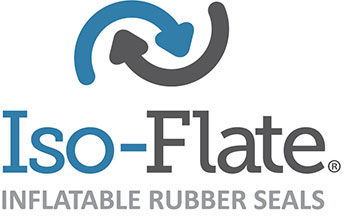Inflatable Seal Frequently Asked Questions
Q: Is it possible to use inflatable seals on doors and frames with 90 degree corners?
A: Yes; but only if the inflatable seal inflates in an axial direction. Inflating inwardly or outwardly onto 90 degree corners will always leave some level of leakage as it is not geometrically possible to stretch a rubber seal to the extent that the contact creates a hermetic seal at the corner point.
Q: What is the largest inflation range possible for an inflatable seal?
A: This is (within reason) unlimited. The range of an inflatable seal is dictated by many factors (material, orientation etc) but mostly by the available space for the profile and housing. For example, common stock seals no larger than 40 x 40mm relaxed can achieve up to 30mm movement , but vacuum membrane assemblies (a clamped moulded rubber seal which is formed in inflated seal position and then vacuumed into housing to provide clearance) have been used by ISO-FLATE clients to seal a range of over 100mm!
Q: What are the maximum operating and system pressures for inflatable seals?
A: The maximum inflation and system pressure is dictated by many factors , but most important is the seal gap (or required travel). For example low pressure seals like the SP101 can travel comfortably above 10mm at 15-30PSI (These seals are often used in relatively low pressure environments such as containment isolators) this however leaves the seal exposed far from the groove and high pressures can act on the exposed seal and force displacement causing a leak.
For a high internal pressure environments (such as autoclave door inflatable seals) a smaller seal gap is required. An example of this is SP15A profile which is designed ideally for 1-2mm travel. This means that the upper seal wall thickness is greater than the gap, meaning it is not possible to force the seal from the groove under high pressure.
It is never advisable to inflate a seal to high pressure when it is not restricted by groove on three sides and a seal face.
Q: What materials are inflatable seals available in?
A: Whilst FDA silicone is the most commonly stocked profile for ISO-FLATE inflatable seals due to its broad scope for pharmaceutical sector , the following materials have been developed for when application demands …..
· EPDM FDA (also available conductive)
· VITON ® /FKM
· Anti Microbial Silicone (BIO-FLATE )
· USP class VI Silicone
· HNBR
Q: How long will my inflatable seal last?
A- Many factors will affect this for example chemical resistance, number of cycles / day and seal pressure to name but a few. However we have the ability to run accelerated cycle tests (conducting over 30,000 inflate / deflate cycles per day in some cases seal size dependant) in order to give clients an accurate estimate driven by application specific data. An example of this is a cycle test we conducted for a steriliser seal inside an oven in order to mimic actual operating environment temperature.
Q: What colours are available ?
A: Most profiles are stocked in white, blue , black and red however we have the ability to colour match compounds given a ral number in order to ensure your inflatable seals match your corporate branding.
If you have a specific question not answered here please contact us.
